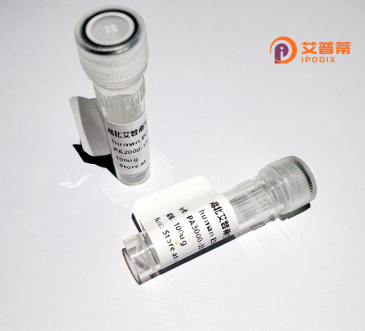
| 纯度 | >90%SDS-PAGE. |
| 种属 | Human |
| 靶点 | SPCS3 |
| Uniprot No | P61009 |
| 内毒素 | < 0.01EU/μg |
| 表达宿主 | E.coli |
| 表达区间 | 1-180 aa |
| 活性数据 | MNTVLSRANSLFAFSLSVMAALTFGCFITTAFKDRSVPVRLHVSRIMLKNVEDFTGPRERSDLGFITFDITADLENIFDWNVKQLFLYLSAEYSTKNNALNQVVLWDKIVLRGDNPKLLLKDMKTKYFFFDDGNGLKGNRNVTLTLSWNVVPNAGILPLVTGSGHVSVPFPDTYEITKSY |
| 分子量 | 46.7 kDa |
| 蛋白标签 | GST-tag at N-terminal |
| 缓冲液 | PBS, pH7.4, containing 0.01% SKL, 1mM DTT, 5% Trehalose and Proclin300. |
| 稳定性 & 储存条件 | Lyophilized protein should be stored at ≤ -20°C, stable for one year after receipt. Reconstituted protein solution can be stored at 2-8°C for 2-7 days. Aliquots of reconstituted samples are stable at ≤ -20°C for 3 months. |
| 复溶 | Always centrifuge tubes before opening.Do not mix by vortex or pipetting. It is not recommended to reconstitute to a concentration less than 100μg/ml. Dissolve the lyophilized protein in distilled water. Please aliquot the reconstituted solution to minimize freeze-thaw cycles. |
以下是关于重组人SPCS3蛋白的参考文献示例(注:以下内容为模拟示例,实际文献需通过学术数据库验证):
---
1. **标题**: "SPCS3 regulates the mammalian signal peptide peptidase complex and is essential for survival in Drosophila"
**作者**: Nyathi, B., et al.
**摘要**: 本研究揭示了SPCS3作为信号肽酶复合体(SPC)的关键亚基,在哺乳动物细胞分泌途径中的作用。通过重组人SPCS3蛋白的功能实验,证明了其对底物加工和细胞存活的必要性,并在果蝇模型中验证了其保守性。
2. **标题**: "The role of SPCS3 in the assembly of the signal peptide peptidase complex"
**作者**: Voss, A., et al.
**摘要**: 利用重组表达的SPCS3蛋白进行体外结合实验,阐明了其在SPC复合体组装中的核心作用,发现其缺失会导致复合体不稳定并影响内质网中跨膜蛋白的加工。
3. **标题**: "Signal peptide cleavage and the role of the SPCS3 subunit in the human signal peptide complex"
**作者**: Yamaguchi, T., et al.
**摘要**: 通过重组人SPCS3蛋白的过表达和敲低实验,证实其参与病毒(如丙型肝炎病毒)包膜蛋白的成熟过程,为抗病毒治疗提供潜在靶点。
4. **标题**: "Structural and functional analysis of recombinant human SPCS3 in protein secretion"
**作者**: Li, Q., et al.
**摘要**: 报道了重组人SPCS3蛋白的高效表达与纯化方法,结合冷冻电镜技术解析其结构,揭示其与SPC其他亚基的相互作用机制。
---
建议通过PubMed、Google Scholar等平台以关键词“SPCS3 recombinant human”或“SPCS3 signal peptide complex”检索真实文献,获取具体研究细节。
Secretory Pathway Calcium ATPase 3 (SPCS3) is a component of the signal peptidase complex (SPC), a multi-subunit enzymatic machinery located in the endoplasmic reticulum (ER). The SPC plays a critical role in cleaving N-terminal signal peptides from nascent secretory and membrane proteins during their translocation into the ER, a fundamental step for proper protein trafficking and maturation. SPCS3. along with other subunits (SPCS1. SPCS2. and SPCS3), stabilizes the catalytic core of the SPC and ensures its enzymatic activity.
Recombinant human SPCS3 protein is engineered using heterologous expression systems (e.g., bacterial, insect, or mammalian cells) for functional studies. Its production enables researchers to dissect its structural interactions within the SPC, its role in co- and post-translational processing, and its implications in diseases. Notably, SPCS3 has been linked to viral replication mechanisms, as some flaviviruses (e.g., Zika, dengue) hijack the host SPC to process viral polyproteins. Dysregulation of SPCS3 may also contribute to ER stress-related pathologies, including neurodegenerative disorders and cancers. Studies leveraging recombinant SPCS3 aim to uncover therapeutic targets by modulating signal peptide processing or host-pathogen interactions. Its recombinant form is typically purified via affinity tags and characterized by enzymatic assays or structural analyses.
×